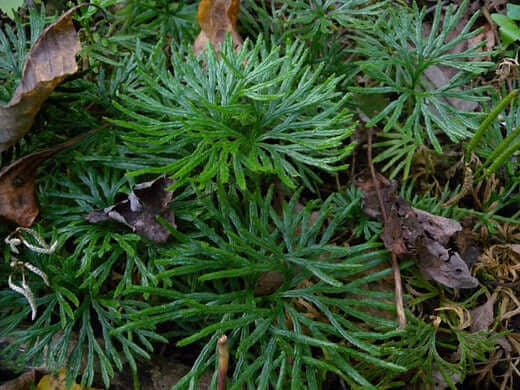Fan clubmoss goes by several names, most of which compare its appearance to something else. Common names include crowsfoot and ground cedar, and it has also been referred to as bear's paws. Its botanical name is Diphasiastrum digital, which hails from the Lycopodium family.
Despite its many names, one thing is sure. It is not a moss. They are more similar to ferns and mushrooms, which reproduce via spores rather than seeds.
It does best in hardiness zones 4 to 7. An evergreen groundcover, this perennial plant grows only 3 to 8 inches in height. Colonies are typically found in mixed woodland and upland pine forests. It prefers dappled sunlight, light shade, and slightly acidic, well-drained, moist soils. The plants often provide cover for ground-nesting birds.

It is recognized by its tiny, pointed, and scale-like, deep-green foliage. Once spores are established, the plants are spread by rhizome stems, which grow not underground but under leaf litter along the forest floor. Extremely slow-growing, the stems shoot up pale yellow, cone-like protuberances called stromboli, where packages of spores are formed. Spores are released to the wind in late summer and into the autumn.
It can take years for spores to establish themselves as plants, and it can be pretty tricky to propagate or transplant. However, transplanting is best successful if plants are deeply dug up to include a large clump of soil surrounding the plant, taking special care not to disturb roots. Gardeners fortunate to have a woodland area with established species would be best served by leaving the plants where they are instead of creating a quiet path into the woods and employing them as part of a secret garden. A mix of colorful wildflowers can make a beautiful enhancement.
Fan clubmoss has been oft-compared in appearance to full-size evergreens such as arborvitaes and cedars. Interestingly, its distant cousins can be traced back 410 million years ago to the Carboniferous period, where the atmosphere was significantly different, and similar plants grew to over 130 feet in height. Today those distant cousins are part of the coal deposits mined throughout the northern hemisphere.
The plants are homeopathic remedies for digestive disorders, including constipation, irritable bowel syndrome, heartburn, skin irritations, sore throats, and fatigue. Lycopodium powder from fan clubmoss is used as pill coatings. The plants also contain combustible oils, which have been used for pyrotechnics and science demonstrations. They have also been used to fashion Christmas greenery.
Exploring the Practical Uses of Fan Clubmoss
The genus Diphasiastrum, known as fan clubmoss or ground cedar and running cedar, grows low to the ground as an evergreen plant, which you can find in both woodlands and mountainous areas. The scale-like leaves of fan clubmoss grow in fan-shaped branches, which give it a miniature conifer-like appearance. Even though these plants do not belong to the moss family nor valid clubmoss species such as the spore-producing Lycopodium varieties, they have maintained significant human use for hundreds of years. This plant demonstrates several important uses ranging from traditional decorative practices to medicinal benefits and its positive impact on ecological systems.
Fan clubmoss primarily serves as a decorative element for ornamental purposes. The lush, evergreen appearance of fan clubmoss attracts both florists and hobbyists. Cut branches from the plant retain their form and hue, making them ideal for wreaths, centerpieces, and small decorative botanicals in homes. Historically, people collected fan clubmoss sprigs for holiday table decorations and miniature "greens" in wreaths and swags. The cultural importance of this plant is enhanced by longstanding regional traditions that have persisted through multiple generations. Conservation groups warn collectors about the dangers of overharvesting and advise them to gather this plant responsibly while following local rules.
In addition to serving decorative purposes, fan clubmoss has been traditionally utilized within specific folk medicine applications. The formal scientific study of Diphasiastrum species remains sparse compared to other popular medicinal plants, but traditional cultural knowledge identifies them as having anti-inflammatory and diuretic properties. Users have prepared herbal teas from the leaves to treat mild inflammation and respiratory problems. Several people think this plant promotes urinary health through increased urination, but scientific research needs to verify these claims.
Outside the Lycopodium genus, members of the Clubmoss family provided flammable spores that became essential in-theater special effects and early photography flash technology. The fan clubmoss receives less mention for its spores than members of the Lycopodium genus, even though clubmoss species have maintained specific shared characteristics throughout history, especially as ceremonial elements. Both indigenous communities and early European residents devised inventive methods to use these plants in their festive occasions and cultural rituals.
Fan clubmoss contributes essential functions to the forest understory ecology. The plant forms dense mats that secure topsoil on inclines while preventing erosion through its root systems, which intermingle with leaf debris. This plant integrates into a varied ecosystem that provides essential support for insects and small creatures. The plant remains green throughout the year, which allows it to provide limited protection during winter under its dense tangle of branches.
Botany and environmental conservation experts advocate sustainable methods for harvesting and growing fan clubmoss today. Responsible gardeners can cultivate this plant in partial-shade gardens or woodland landscapes to enable its slow expansion as a soft evergreen ground cover. Commercial propagation remains difficult because fan clubmoss grows at a slow pace. People who harvest or gather fan clubmoss for decorative purposes must understand and follow local laws safeguarding its wild populations.
The multifaceted uses of fan clubmoss extend beyond its woodland beauty to include applications in wreath-making, erosion control, and historical medicinal purposes. By recognizing its understated beauty and ecological function, people can maintain responsible usage while preserving the plant across various ecosystems for descendants to enjoy.
Read more

For those that may have a bit extra money to spend, there are ways to add some class and flair to your garden. Your yard should be a place where you can spend time and relax.You can read a book or ...

Reasons You Should Plan to PlantIn the past few decades, trees have become one of the many horticultural casualties of the excellent housing spread. Suburban developments sprouted seemingly overnig...


